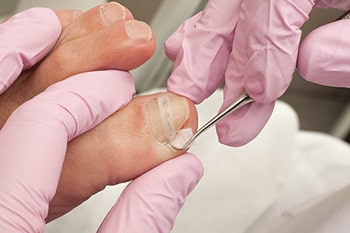
Signs that may indicate the formation of an ingrown toenail include redness, pain, swelling of the surrounding skin, possible bleeding or oozing of pus, and an overgrowth of the skin around the nail. The surrounding skin may also feel tender and become swollen or hardened. Most ingrown toenails are diagnosed by a simple physical exam; however, an x-ray may be required to show how deep the nail has grown into the skin of the toe. An xray may also reveal a bone spur that has developed on the bone under the nail which can deform the nail plate.
Many factors influence the likelihood of developing an ingrown toenail. The most common way ingrown toenails are formed is due to an incorrect method in how the toenails are trimmed. If you cut your toenails too short or cut them at an angle, you’re putting yourself at risk of getting this condition. Another main factor that contributes to ingrown toenails is the choice of footwear. Those who commonly wear tightly fitted shoes, such as high heels, that do not give the toes enough room, put too much pressure on the big toes. This can create an ingrown toenail. Some people can alleviate their pain, a very small piece of cotton may be fitted underneath the nail. However, in more serious cases, the ingrown nail removal of the nail may be necessary. If the nail plate deformed or curved into the skin and especially if it is a chronic issue, the podiatrist can permanent remove only the ingrown or offending portion of the nail.
For a proper diagnosis and advised treatment plan, we recommend you seek the care of a podiatrist as soon as you notice the warning signs of an ingrown toenail.
Condition:
An ingrown toenail is a painful condition of the toe. Any toenail can become ingrown, but the condition is usually found in the big toe. It occurs when a sharp corner of the toenail digs into the skin at the end of or side of the toe.
Symptoms:
Pain and inflammation at the spot where the nail digs into the skin occurs first. Later, the inflamed area can begin to grow tissue or drain yellowish fluid. Ingrown toenails are common in adults and children. Teenagers and young adults tend to be at more risk due to the way they peel or cut their nails. If left untreated, an ingrown toenail can progress to an infection or even an abscess that requires surgical treatment.
Treatment:
Treatment involves removing the offending nail border with temporary and allow new nail growth or with chronic conditions a permanent nail excision can be done. Performed in our office, this procedure usually takes about 10-15 minutes. The majority of the time, you will be able to leave our office wearing the shoes you wore to your appointment. Aftercare includes daily foot soaking and topical antibiotic treatment for approximately 2-4 weeks depending on the procedure and severity.
Prevention:
- Trim your toenails straight across with no rounded corners
- When getting pedicures don’t allow technician to cut into corners
- Ensure that your shoes and socks are not too tight
- Keep your feet and toes clean at all times



